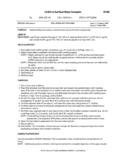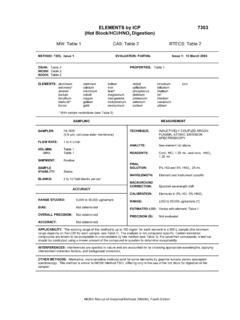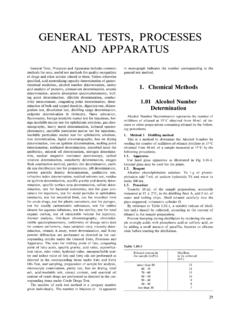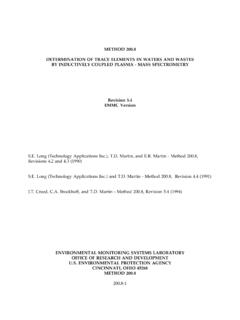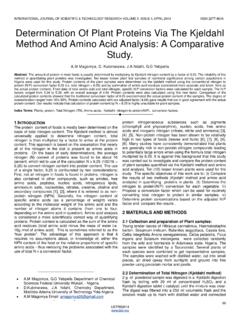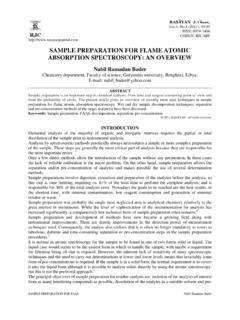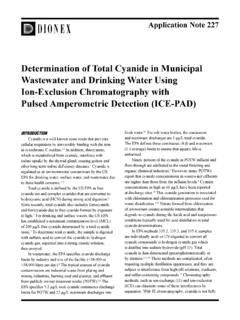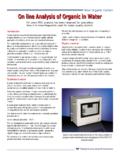Transcription of Method 365.3: Phosphorous, All Forms (Colorimetric ...
1 1978 Method : Phosphorous, All Forms (Colorimetric, Ascorbic Acid, Two Reagent) Method #: Approved for NPDES (Issued 1978) TITLE: Phosphorous, All Forms (Colorimetric, Ascorbic Acid, Two Reagent) ANALYTE: CAS # P Phosphorus 7723-14-0 INSTRUMENTATION: Spectrophotometer STORET No. See Section 4 Scope and Application These methods cover the determination of specified Forms of phosphorus in drinking, surface and saline waters, domestic and industrial wastes. The methods are based on reactions that are specific for the orthophosphate ion.
2 Thus, depending on the prescribed pretreatment of the sample, the various Forms may be determined. Except for in-depth and detailed studies, the most commonly measured Forms are phosphorus and dissolved phosphorus, and orthophosphate and dissolved orthophosphate. Hydrolyzable phosphorus is normally found only in sewage-type samples and insoluble Forms of phosphorus are determined by calculation. The methods are usable in the to mg P/L range. Summary of Method Ammonium molybdate and antimony potassium tartrate react in an acid medium with dilute solutions of phosphorus to form an antimony-phospho-molybdate complex.
3 This complex is reduced to an intensely blue-colored complex by ascorbic acid. The color is proportional to the phosphorus concentration. Only orthophosphate Forms a blue color in this test. Polyphosphates (and some organic phosphorus compounds) may be converted to the orthophosphate form by sulfuric acid hydrolysis. Organic phosphorus compounds may be converted to the orthophosphate form by persulfate digestion . Sample Handling and Preservation If benthic deposits are present in the area being sampled, great care should be taken notto include these deposits.
4 Sample containers may be of plastic material, such as cubitainers, or of Pyrex glass. If the analysis cannot be performed the day of collection, the sample should be preserved by the addition of 2 mL conc. H 2SO4 pr liter and refrigeration at 4 Definitions and Storet Numbers Total Phosphorus (P)--all of the phosphorus present in the sample, regardless of form, as measured by the persulfate digestion procedure. (00665) Total Orthophosphate (P, ortho)--inorganic phosphorus [(PO ) -34 ] in thesample as measured by the direct colorimetric analysis procedure.
5 (70507) Total Hydrolyzable Phosphorus (P, hydro) - phosphorus in the sample as measured by the sulfuric acid hydrolysis procedure, and minus pre-determined orthophosphates. This hydrolyzable phosphorus includes polyphosphorus. [(P -4 27 O ) , (P 31O 0 ) -5, etc.] plus some organicphosphorus. (00669) Total Organic Phosphorus (P, org)--phosphorus (inorganic plus oxidizable organic) in the sample measured by the persulfate digestion procedure, and minus hydrolyzable phosphorus and orthophosphate. (00670) Dissolved Phosphorus (P-D)--all of the phosphorus present in the filtrate of a sample filtered through a phosphorus-free filter of micron pore size and measured by the persulfate digestion procedure.
6 (00666) Dissolved Orthophosphate (P-D, ortho)--as measured by the direct colorimetric analysis procedure.(00671) Dissolved Hydrolyzable Phosphorus (P-D, hydro)--as measured by the sulfuric acid hydrolysis procedure and minus pre-determined dissolved orthophosphates. (00672) Dissolved Organic Phosphorus (P-D, org)--as measured by the persulfate digestion procedure, and minus dissolved hydrolyzable phosphorus and orthophosphate. (00673) The following Forms , when sufficient amounts of phosphorus are present in the sample to warrant such consideration, may be calculated: Insoluble Phosphorus (P-I) = (P)-(P-D).
7 (00667) Insoluble orthophosphate (P-I, ortho)=(P, ortho) - (P-D, ortho). (00674) Insoluble Hydrolyzable Phosphorus (P-I, hydro)=(P, hydro)-(P-D, hydro). (00675) Insoluble Organic Phosphorus (P-I, org)=(P, org) - (P-D, org). (00676) All phosphorus Forms shall be reported as P, mg/L, to the third place. Interferences Arsenate is determined similarly to phosphorus and should be considered when present. This interference may be eliminated by reducing the arsenic acid to arsenious acid with sodium bisulfite ( ).
8 When high concentrations of iron are present low recovery of phosphorus will be obtained because it will use some of the reducing agent. The bisulfite treatment will also eliminate this interference. Apparatus Photometer-A spectrophotometer or filter photometer suitable for measurements at 660 or 880 nm with a light path of 1 cm or longer. Acid-washed glassware: All glassware used should be washed with hot 1:1 HCl and rinsed with distilled water. The acid-washed glassware should be filled with distilled water and treated with all the reagents to remove the last traces of phosphorus that might be absorbed on the glassware.
9 Preferably, this glassware should be used only for the determination of phosphorus and after use it should be rinsed with distilled water and kept covered until needed again. If this is done, the treatment with 1:1 HCl and reagents is only required occasionally. Commercial detergents should never be used. Waterbath, 95 C. Reagents Ammonium molybdate-antimony potassium tartrate solution: Dissolve 8 g of ammonium molybdate and g antimony potassium tartrate in 800 mL of distilled water and dilute to 1 liter.
10 Ascorbic acid solution: Dissolve 60 g of ascorbic acid in 800 mL of distilled water and dilute to 1 liter. Add 2 mL of acetone. This solution is stable for two weeks. Sulfuric acid, 11 N: Slowly add 310 mL of conc. H 2SO4 to approximately 600mL distilled water. Cool and dilute to 1000 mL. Sodium bisulfite (NaHSO 3 ) solution: Dissolve g of NaHSO3 in 100 mL of Ammonium persulfate. Stock phosphorus solution: Dissolve g of predried (105 C for one hour) KH 2PO4 in distilled water and dilute to 1000 mL.










